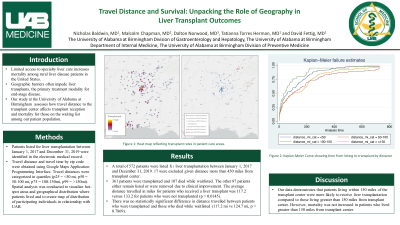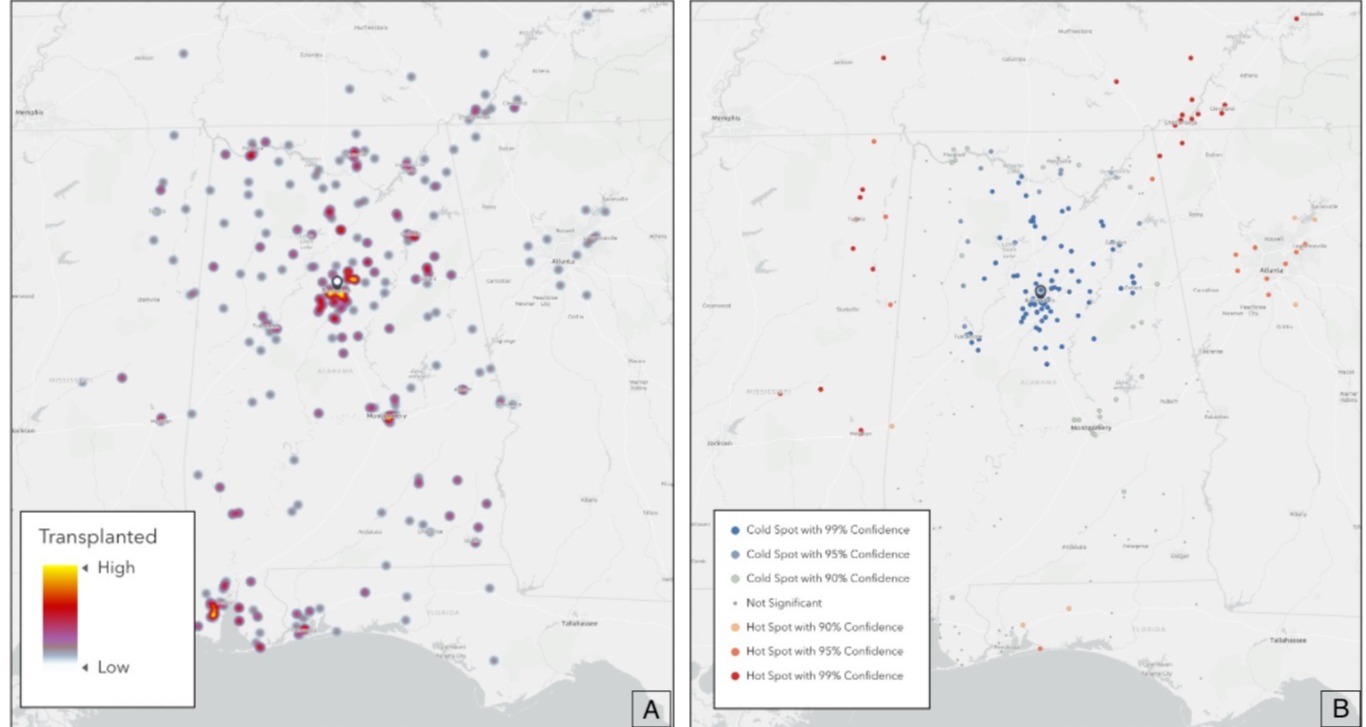Monday Poster Session
Category: Liver
P2384 - Travel Distance and Survival: Unpacking the Role of Geography in Liver Transplant Candidates
Monday, October 23, 2023
10:30 AM - 4:15 PM PT
Location: Exhibit Hall

Has Audio
- NB
Nicholas Baldwin, MD
University of Alabama at Birmingham
Birmginham, AL
Presenting Author(s)
Nicholas Baldwin, MD1, Malcolm Chapman, MD2, Dalton A. Norwood, MD3, Tatiana Torres Herman, MD2, David Fettig, MD2
1University of Alabama at Birmingham, Birmginham, AL; 2University of Alabama at Birmingham, Birmingham, AL; 3UAB Minority Health and Health Equity Research Center, The University of Alabama at Birmingham Heersink School of Medicine, Birmingham, AL
Introduction: Limited access to specialty care increases mortality among patient with chronic liver disease in rural areas of the United States. Geographic barriers often impede care, including transplant, the primary treatment for end-stage liver disease. Our study assesses how travel distance to transplant center affects transplant reception and mortality for those on the waiting list among our patient population at The University of Alabama at Birmingham (UAB).
Methods: Patients listed for liver transplantation between January 1, 2017 and December 31, 2019 were identified in the electronic medical record. Travel distance and travel time by zip code were obtained using Google Maps Application Programming Interface. Patients living greater than 450 miles from transplant center were excluded from analysis. Comparison of means was performed using a two-sided T-test and non-parametric comparison of medians was assessed using Kruskal-Wallis test. Spatial analysis was conducted to visualize hot-spot areas and geographical distribution where patients lived and to create map of distribution of participating individuals in relationship with UAB.
Results: 572 patients were listed for liver transplantation between January 1, 2017 and December 31, 2019. Of these, 17 were excluded given distance more than 450 miles from transplant center. Of the remaining 555 patients, 361 patients were transplanted and 107 died while waitlisted. The other 87 patients either remain listed or were removed due to clinical improvement. The mean distance travelled in miles for patients who received a liver transplant was 117.2 ± 81.0 versus 133.2 ± 83.0 for patients who were not transplanted (p = 0.0145). < 150 miles resulted in a higher rate of transplantation (67.9%) compared to those living > 150 miles (32.1%) p=0.024. There was no statistically significant difference in distance travelled between patients who were transplanted and those who died while waitlisted (117.2 mi vs 124.7 mi, p = 0.7869).
Discussion: The mean distance traveled by patients who received a liver transplant was lower compared to those who were not transplanted. Patients living within 150 miles of the transplant center had a significantly higher transplantation rate compared to those living farther away, indicating a potential correlation between distance and rate of transplantation. However, when comparing patients who received transplants with those who died while on the waitlist, no statistically significant difference in distance traveled was observed.

Disclosures:
Nicholas Baldwin, MD1, Malcolm Chapman, MD2, Dalton A. Norwood, MD3, Tatiana Torres Herman, MD2, David Fettig, MD2. P2384 - Travel Distance and Survival: Unpacking the Role of Geography in Liver Transplant Candidates, ACG 2023 Annual Scientific Meeting Abstracts. Vancouver, BC, Canada: American College of Gastroenterology.
1University of Alabama at Birmingham, Birmginham, AL; 2University of Alabama at Birmingham, Birmingham, AL; 3UAB Minority Health and Health Equity Research Center, The University of Alabama at Birmingham Heersink School of Medicine, Birmingham, AL
Introduction: Limited access to specialty care increases mortality among patient with chronic liver disease in rural areas of the United States. Geographic barriers often impede care, including transplant, the primary treatment for end-stage liver disease. Our study assesses how travel distance to transplant center affects transplant reception and mortality for those on the waiting list among our patient population at The University of Alabama at Birmingham (UAB).
Methods: Patients listed for liver transplantation between January 1, 2017 and December 31, 2019 were identified in the electronic medical record. Travel distance and travel time by zip code were obtained using Google Maps Application Programming Interface. Patients living greater than 450 miles from transplant center were excluded from analysis. Comparison of means was performed using a two-sided T-test and non-parametric comparison of medians was assessed using Kruskal-Wallis test. Spatial analysis was conducted to visualize hot-spot areas and geographical distribution where patients lived and to create map of distribution of participating individuals in relationship with UAB.
Results: 572 patients were listed for liver transplantation between January 1, 2017 and December 31, 2019. Of these, 17 were excluded given distance more than 450 miles from transplant center. Of the remaining 555 patients, 361 patients were transplanted and 107 died while waitlisted. The other 87 patients either remain listed or were removed due to clinical improvement. The mean distance travelled in miles for patients who received a liver transplant was 117.2 ± 81.0 versus 133.2 ± 83.0 for patients who were not transplanted (p = 0.0145). < 150 miles resulted in a higher rate of transplantation (67.9%) compared to those living > 150 miles (32.1%) p=0.024. There was no statistically significant difference in distance travelled between patients who were transplanted and those who died while waitlisted (117.2 mi vs 124.7 mi, p = 0.7869).
Discussion: The mean distance traveled by patients who received a liver transplant was lower compared to those who were not transplanted. Patients living within 150 miles of the transplant center had a significantly higher transplantation rate compared to those living farther away, indicating a potential correlation between distance and rate of transplantation. However, when comparing patients who received transplants with those who died while on the waitlist, no statistically significant difference in distance traveled was observed.

Figure: A: Heat map showing location of patients who received transplant after listing at The University of Alabama at Birmingham between January 1, 2017 and December 31, 2019.
B: Heat map indicating areas of low transplantation rate (hot spot) versus areas of high transplantation rate (cold spot).
B: Heat map indicating areas of low transplantation rate (hot spot) versus areas of high transplantation rate (cold spot).
Disclosures:
Nicholas Baldwin indicated no relevant financial relationships.
Malcolm Chapman: CVS Health – Employee.
Dalton Norwood indicated no relevant financial relationships.
Tatiana Torres Herman indicated no relevant financial relationships.
David Fettig indicated no relevant financial relationships.
Nicholas Baldwin, MD1, Malcolm Chapman, MD2, Dalton A. Norwood, MD3, Tatiana Torres Herman, MD2, David Fettig, MD2. P2384 - Travel Distance and Survival: Unpacking the Role of Geography in Liver Transplant Candidates, ACG 2023 Annual Scientific Meeting Abstracts. Vancouver, BC, Canada: American College of Gastroenterology.
